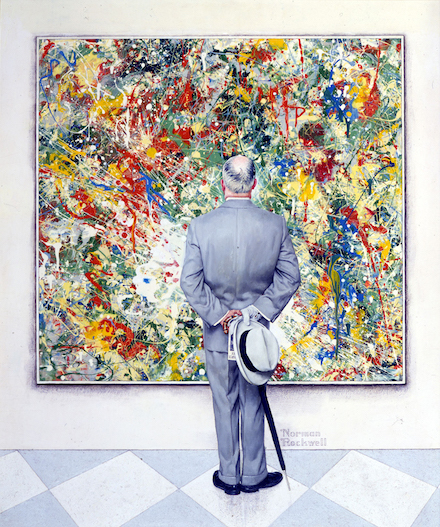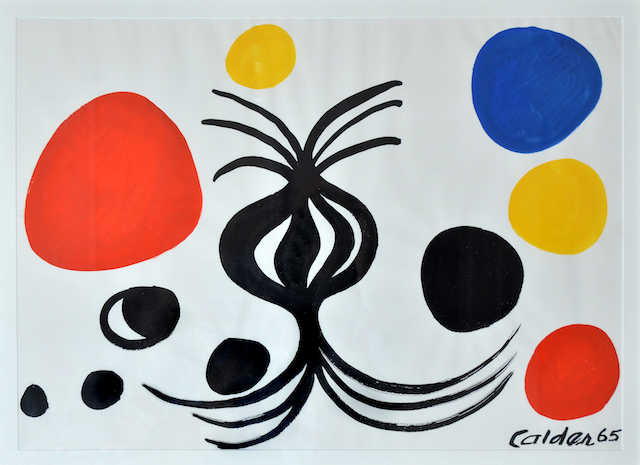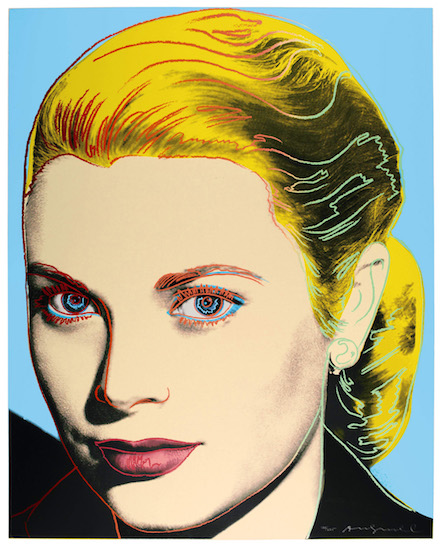
Norman Rockwell (1894-1978), “The Connoisseur,” 1961. Oil on canvas mounted on board, 37 3/4″ x 31 1/2″. Cover illustration for “The Saturday Evening Post,” January 13, 1962. Private collection. ©SEPS: Curtis Licensing, Indianapolis, IN
(STOCKBRIDGE, Mass.) – For the first time ever, Norman Rockwell Museum will explore the contrast between the abstract and realist movements, placing works by Rockwell, Andrew Wyeth, and Andy Warhol side by side with Jackson Pollock, Alexander Calder, Jasper Johns, and over 40 other preeminent artists, including Walton Ford, Larry Rivers, Helen Frankenthaler, Jeff Koons, Anita Kunz, Jacqui Morgan, Robert Motherwell, Barnett Newman, Philip Pearlstein, Robert Rauschenberg, David Salle, Saul Steinberg, and Cy Twombly.
“Rockwell and Realism in an Abstract World,” on view from Friday, June 17, through October 30, will examine the forces that forged the mid-century dismissal of narrative painting and illustration, as well as the resurgence of realist painting during the latter half of the twentieth century, its presence and critical consideration today, and the ways in which our contemporary viewpoints have been shaped by post World War II constructs.
The exhibition’s official opening reception will take place on Thursday, July 14, at 6:30pm, and will include remarks from featured artists.
Beloved as he was during his six-decade career, artist Norman Rockwell found himself a “man out of time” when it came to many of the prevailing trends taking place in the art world. He famously commented that, “I love it when I get admiring letters from people. And, of course, I’d love it if the critics would notice me, too,” yet acknowledged his place in the art world: “My ability evidently lies in telling stories, and modern art doesn’t go in much for that sort of thing.”
“In the 1950s, there was heated debate about the relative merits of abstract art, realist art, and popular illustration, and Norman Rockwell was frequently caught in the crossfire,” notes Norman Rockwell Museum director/CEO Laurie Norton Moffatt. “The symbolic artist against whom the art world turned, Rockwell even tried his own hand at modernism in his Jackson Pollock-styled painting ‘The Connoisseur,’ which will be featured in the exhibition, on loan from a private collection. We look forward to exploring this rebellious turning point in American art, when many artists rejected Rockwell’s version of realism and invented a nonrepresentational artistic vocabulary.”

Black Onion, 1966. Alexander Calder. © 2016 Calder Foundation, New York / Artists Rights Society (ARS), New York. Collection of John Frank. All rights reserved.
“When Norman Rockwell and his illustrator colleagues worked to enliven the pages of American magazines, they were pushing against the tide,” explains museum deputy director/chief curator Stephanie Plunkett. “By the late 1940s, shifts in technology — which brought the world to the masses through photography and television — and challenges by modernist art idioms, conspired to relegate conventional illustration to a lesser status. Traditional narrative illustration was a waning discipline, and though Rockwell was a hero to many, he was also an institution to younger artists who viewed him as the old guard. For all of his complexity, Rockwell became a catalyst for change for illustrators seeking to blur the lines between fine and applied art.”
In post-World War II America, the primacy of abstract art was clearly acknowledged, and by 1961, when Rockwell painted “The Connoisseur,” Abstract Expressionism had been covered in the popular press for nearly 15 years. Originated in the 1940s by Pollock, Willem de Kooning, Franz Kline, Barnett Newman, and Mark Rothko, among others, Abstract Expressionism was the first American movement to achieve widespread international influence.
While “The Connoisseur” juxtaposes the conservative with the avant-garde, it offers no clues to Rockwell’s opinion of modern art. “You don’t know what he’s thinking,” he said of the viewer whose face he did not snow. Willem de Kooning reportedly commented that, “Square inch by square inch, it’s better than Jackson!”
After completing the work, Rockwell submitted a section of one of his studies to an exhibition at the Cooperstown Art Association in New York, signing the canvas with an Italian signature. It took first place for painting, and another section of the abstract study, signed under his middle name Percival, won honorable mention at an exhibition at the Berkshire Museum. Three painterly studies for “The Connoisseur” are featured in this new exhibition.

Grace Kelly, 1984. Andy Warhol. ©2016 The Andy Warhol Foundation for the Visual Arts, Inc. / Artists Rights Society (ARS), New York. Private Collection. Use of the image of Princess Grace of Monaco with permission of the Princess Grace Foundation-USA, which supports emerging artists in theater, dance, and film; www.pgfusa.org.
“Rockwell and Realism in an Abstract World” features the art of prominent illustrators, painters, and sculptors whose autographic art spans more than 60 years, representing many dynamic forms of visual communication. Featured artists include Marshall Arisman, Bo Bartlett, Austin Briggs, Alexander Calder, Alan E. Cober, Robert Cottingham, Robert Cunningham, Joe De Mers, Walton Ford, Eric Forstmann, Helen Frankenthaler, Bernie Fuchs, Sam Francis, Edwin Georgi, George Giusti, Ralph Goings, Cleve Grey, Brad Holland, Dan Howe, Jasper Johns, Jeff Koons, Anita Kunz, Jacqui Morgan, Robert Motherwell, Barbara Nessim, Barnett Newman, Tim O’Brien, Claes Oldenburg and Coosje Van Bruggen, Al Parker, Bob Peak, Philip Pearlstein, Jackson Pollock, Robert Rauschenberg, Larry Rivers, Norman Rockwell, James Rosenquist, David Salle, Saul Steinberg, Cy Twombly, Andy Warhol, Robert Weaver, Thomas Woodruff, Andrew Wyeth, and Jamie Wyeth.
Artworks have generously been placed on loan by Smithsonian American Art Museum, Museum of Modern Art, Brooklyn Museum, Boca Raton Museum of Art, Sheldon Museum of Art, Society of Illustrators Museum of American Illustration, Estate of Roy Lichtenstein, Jane Eckert Fine Art, Betty Cunningham Gallery, Pace Gallery, P.P.O.W. Gallery, Illustrated Gallery, Universal Limited Art Editions (ULAE), Foundation for Contemporary Arts, Seven Bridges Foundation, Saul Steinberg Foundation, John V. Frank, Ellen Cober, Lynn Kearcher and Carl Chaiet, Sandy and George Garfunkel, Andrew Nelson, Phyllis and Jamie Wyeth, and several private collectors.
Recent acquisitions to the museum’s expansive collection of original illustration art will also be included in this exhibition, including works by Barbara Nessim, Joe De Mers, Robert Cunningham, Robert Weaver, Anita Kunz, Jacqui Morgan, Robert Peak, Bernie Fuchs, and George Giusti. An exhibition video, produced by the Museum, will present insights from contemporary critics and artists included in the exhibition.
Exhibition-Related Programs
Thursday Evening Lecture and Performance Series
Real or Imagined? Adventures in Visual Culture
Thursdays in July and August, 5:30 p.m.
Enjoy this engaging series of talks and performances inspired by “Rockwell and Realism in an Abstract World,” and the persuasive power of visual imagery in its many forms. Free for Museum members, or included with Museum admission. Reservations are suggested.
Diversity, Perception, and Responsibility in Illustration
with Robyn Phillips-Pendelton
Thursday, July 7
Explore blatant, subtle, or perceived racial stereotypes created by illustrators, and sanctioned by art directors and publishers, have been woven into the fabric of the relationship between imagery and text, and shaped American’s perception of race for over four centuries. Robyn Phillips-Pendleton, Associate Professor of Visual Communication at the University of Delaware, is an artist for the United States Air Force Art Program, and has created illustrations for magazines, books, and educational institutions.
Rockwell and Realism in an Abstract World
Exhibitions Opening Event
Thursday, July 14
A festive reception for the exhibition, including remarks from featured artists at 6:30 p.m. Explore the schism between realist and abstract art, which relegated narrative painting—and especially illustration—to a lesser status in mid-twentieth century America.
Realism and the Persistence of Memory
with Robert Cottingham, Eric Forstmann, and Jane Eckert
Thursday, July 21
Join acclaimed painters Robert Cottingham and Eric Forstmann, and artists’ representative Jane Eckert, author, art historian, and founder of Eckert Fine Art, for an insightful conversation about art and the creative process. Perspectives on realism and the role of memory, meaning, and personal inspiration in art will be explored.
Norman Rockwell and the Challenge of Realism with Stephanie Haboush Plunkett
Thursday, July 28
Trace the shifts in twentieth century art and the art of illustration during this exhibition tour with Deputy Director/Chief Curator Stephanie Haboush Plunkett.
Rockwell Suites with the Albany Berkshire Ballet
Thursday, August 4
Experience this special series of dances inspired by Norman Rockwell’s art, choreographed by Founder and Artistic Director Madeline Cantarella Culpo.
A Tribute to Elvis Presley and Early Rock and Roll
Thursday, August 11
Accomplished Elvis impersonator Joe Borelli and his band will bring beloved songs by the “King of Rock and Roll,” and the music of the 1950s, 60s, and 70s, to life.
Benton, Pollock, and the Politics of Modernism: From Regionalism to Abstraction with Erika Doss
Thursday, August 18
Join Professor Erika Doss from the University of Notre Dame for an exploration of a period of historic cultural change in American art from the dominance of regionalism in the 1930s to abstract expressionism in the 1940s. Doss explains the reasons for this change and casts light on its significance for contemporary culture.
The Visual Narrative: Three Perspectives
with Marshall Arisman, Anita Kunz, and Thomas Woodruff
Thursday, August 25
Meet three award-winning illustrators who also create personal works that have their own story to tell. Marshall Arisman’s paintings and drawings have been published widely and exhibited internationally; Anita Kunz’s art appears regularly in “Time,” “Rolling Stone,” “Vanity Fair,” “The New Yorker,” and “GQ,” as well as in galleries and museums; and Thomas Woodruff is a self-proclaimed “neo-fabulist” who works on complex imagistic projects.
Art Talks
Free for Museum members, or included with Museum admission.
American Realist: An Evening with Painter Bo Bartlett
Sunday, July 10, 5 p.m.
An American realist with a modernist vision, Bo Bartlett will offer insights into his work, which celebrates the underlying epic nature of the commonplace and the personal significance of the extraordinary. Free for Museum members, or included with Museum admission.
The Wyeth Legacy: A Family of Artists with Joyce Hill Stoner
Tuesday, July 12, 5:30 p.m.
Trace the artistic legacy of the Wyeth family across three generations, from acclaimed illustrator N.C. Wyeth to his son and grandson, painters Andrew Wyeth and Jamie Wyeth. Joyce Hill Stoner, the Edward F. and Elizabeth Goodman Rosenberg Professor of Material Culture at the University of Delaware, has worked personally with the Wyeths as model, conservator, and author.
Jackson Pollock and the Rise of Abstract Expressionism with Helen A. Harrison
Monday, July 25, 5:30 p.m.
A revolutionary post-World War II art movement, Abstract Expressionism placed America on the international stage as an influential force to be reckoned with in the art world. Join Helen A. Harrison, Director of the Pollock-Krasner House and Study Center, for a fascinating look at the artists and critics who sparked new ways of seeing.
Van Der Zee to Rockwell and Beyond: Art and Civil Rights with Pops Peterson
Saturday, August 6, 5 p.m.
Explore the relationship between art and the civil rights movement with Maurice “Pops” Peterson, who was honored for his series that re-imagined the art of Norman Rockwell to reflect the realities of 21st century life.
About Norman Rockwell Museum
Norman Rockwell Museum holds the largest and most significant collection of art and archival materials relating to the life and work of Norman Rockwell. The Museum also preserves, interprets, and exhibits a growing collection of original illustration art by noted American illustrators, from historical to contemporary. The Norman Rockwell Museum Art Collection and Norman Rockwell Archive inspire a vibrant year-round exhibition program, national traveling exhibitions, and arts and humanities programs that engage diverse audiences. The collections, which are made accessible worldwide, are a comprehensive resource relating to Norman Rockwell and the art of illustration, the role of published imagery in society, and the American twentieth century.
Since its inception, Norman Rockwell Museum has explored the impact of illustrated images and their role in shaping and reflecting our world through changing exhibitions, publications, and programs. Dedication to a deepened understanding of the art of illustration has led to the formation of the Rockwell Center for American Visual Studies. The first of its kind in the nation, this research institute supports sustained scholarship and establishes Norman Rockwell Museum’s leadership in the vanguard of preservation and interpretation relating to this important aspect of American visual culture.
Norman Rockwell Museum is located on 36 park-like acres in Stockbridge, Massachusetts, Rockwell’s hometown for the last 25 years of his life. The Museum is open year-round; closed Thanksgiving, Christmas, and New Year’s Day. From May through October, hours are 10 a.m. to 5 p.m. daily; from November through April, hours are 10 a.m. to 4 p.m. Monday through Friday, and 10 a.m. to 5 p.m. on weekends and holidays. The Museum will be open 10 a.m. to 7 p.m. on Thursdays during the month of August. Rockwell’s studio is open May through October, 10 a.m. to 5 p.m. Museum admission is $18, $17 for seniors, $16 for military veterans, $10 for students, $6 for kids and teens 6 to 18, and free for Museum members and children 5 and under.
